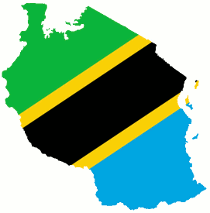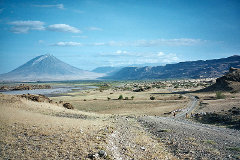Facts
 Tanzania is a country located in central East Africa. To find out more about where Tanzania is, see our Maps page.
Tanzania is a country located in central East Africa. To find out more about where Tanzania is, see our Maps page.
The current head of state is President Jakaya Mrisho Kikwete, elected in 2005. Since 1996, the official capital of Tanzania has been Dodoma, where parliament and some government offices are located. Between independence and 1996 the major coastal city of Dar es Salaam had been the country's political capital. Today Dar es Salaam remains the principal commercial city of Tanzania and the location of most government institutions. It is the major seaport for the country and its landlocked neighbours.
The name Tanzania is an amalgamation of Tanganyika and Zanzibar. The two states united in 1964 to form the United Republic of Tanganyika and Zanzibar, which later the same year was renamed the United Republic of Tanzania.
Arusha
Arusha is a prosperous town (population 400,000) and a leading tourist centre, being close to Mount Kilimanjaro. It is 70 km from the Kenyan border. Arusha is the headquarters for the East African Community and is the seat of several international agencies including the Commonwealth Health Secretariat, the Rwanda Tribunal of the United Nations and the African Wildlife Foundation.
Despite its proximity to the equator, Arusha's elevation of 1400m on the southern slopes of Mount Meru keeps temperatures down and alleviates humidity. Cool dry air is prevalent for much of the year. The temperature ranges between 13 and 30 degrees Celsius with an average around 25 degrees. It has distinct wet and dry seasons, and experiences an eastern prevailing wind from the Indian Ocean, a couple of hundred miles east.
The primary industry of the region is agriculture, with large vegetable and flower producers sending high-quality produce to Europe. Small-scale agriculture was badly hit by the coffee crisis of recent years and is now largely subsistence farming. Arusha has several factories including a brewery, tyre and fibreboard plant, and a large pharmaceutical plant. Arusha is Tanzania's rugby home with the national team playing its international matches there. Tuishime School is located in Arusha, 7km from the town centre.
Demographics
As of 2006, the estimated population is 38,329,000, with an estimated growth rate of 2 percent. Population distribution is extremely uneven, with density varying from 1 person per square kilometer in arid regions to 134 per square kilometer on Zanzibar. More than 80 percent of the population is rural. Dar es Salaam is the largest city and is the commercial capital; Dodoma, located in the center of Tanzania is the new capital and houses the Union's Parliament.
The African population consists of more than 120 ethnic groups, of which the Sukuma and Nyamwezi, the Hehe and Bena, the Gogo, the Haya, the Makonde, the Chagga and the Nyakyusa have more than 1 million members. Other groups include the Pare, Shambaa, and Ngoni. The majority of Tanzanians have Bantu origins. The nomadic Maasai and the Luo are also present.
The population also includes people of Arab, Indian, and Pakistani origin, and small European and Chinese communities.
Economy
The economy is mostly based on agriculture and accounts for more than half of GDP. Agriculture provides 85 percent of exports and employs approximately 80 percent of the workforce. Only 4 percent of the land area is used to cultivate crops.
Industry is mainly limited to processing agricultural products and light consumer goods. Growth from 1991 to 1999 featured a pickup in industrial production and a substantial increase in output of minerals, led by gold. Commercial production of natural gas from the Songo Songo island in the Indian Ocean off the Rufiji Delta commenced in 2004, with natural gas being pumped in a pipeline to the commercial capital Dar es Salaam. The bulk of it is converted to electricity by the public utility and private operators. A new gas field is being brought on stream in Mnazi Bay.
The nation has vast amounts of mineral resources including gold, diamonds, coal, iron ore, uranium, nickel, chrome, tin, platinum, coltan, niobium. It is the third-largest producer of gold in Africa after South Africa and Ghana. Lack of overall development has hampered the extraction of the natural resources. Tanzania is also known for the Tanzanite gemstone.
Tanzania has dozens of beautiful national parks like the world famous Serengeti and the Ngorongoro Conservation Area that generate income from tourism.
Recent public sector and banking reforms and revamped and new legislative frameworks have all helped increase private-sector growth and investment. Short-term economic progress also depends on curbing corruption.
Prolonged drought during the early years of the 21st century has severely reduced electricity generation capacity (some 60 percent of Tanzania's electricity supplies are generated by hydro-electricity.
Education
The provision of basic education often meets with obstacles, in the sense that resources are not available from the government, hence the need to co-opt private investment to help the education sector. One of the main problems is the lack of pre-primary intake for children, and what does exist cannot accommodate the numbers requiring places. Pre-primary intake is important as working mothers are often forced to leave their children in the care of inexperienced and unqualified carers to the detriment of the child's development.
Education is compulsory for seven years, until children reach the age of 15 years. Primary school education has been free in Tanzania since 2002, but families still have the responsibility to pay for uniforms, exam fees and school supplies. Secondary schools are fee paying. Government primary schools teach in the Swahili language whilst all secondary education must be taught in English (excepting Swahili class). This means that most children are at a huge disadvantage when they start secondary school as they not only have to understand new subjects but to do so in a foreign language which most of them have not really studied. English medium schools, such as Tuishime School, are in short supply which prevents pupils reaching any sort of standard in many subjects including Maths and Science. Tanzania hosts several universities.
Geography
At 945,087 km² Tanzania is the world's 31st-largest country. It is comparable in size to Nigeria.
Tanzania is mountainous in the northeast, where Mount Kilimanjaro, Africa's highest peak, is situated. To the north and west are the Great Lakes of Lake Victoria (Africa's largest lake) and Lake Tanganiyka (Africa's deepest lake, known for its unique species of fish). The Great Rift valley passes through the country. The active Ol Doinyo Lengai volcano near the Kenyan border is currently erupting. Central Tanzania comprises a large plateau, with plains and arable land. The eastern shore is hot and humid, with the island of Zanzibar lying just offshore.
Landscape in Northern Tanzania, inside the great Rift valley
Tanzania contains many large and ecologically significant wildlife parks, including the famous Ngorongoro Crater, Serengeti NP in the north, and Selous Game Park and Mikumi National Park in the south.
The Kalambo Falls in southwest Tanzania's region of Rukwa are the second highest in Africa and are located near the southern tip of Lake Tanganyika.
Tanzania has a tropical climate. In the highlands, temperatures range between 10°C and 20°C (50°F and 68°F) during cold and hot seasons respectively. The rest of the country has temperatures rarely falling lower than 20°C (68°F). The hottest period extends between November and February (25°C - 31°C, or 77°F - 88°F) while the coldest period occurs between May and August (15°C - 20°C, or 59°F - 68°F).
Tanzania has two major rainfall regions. One is unimodal (December - April) and the other is bimodal (October -December and March - May). The former is experienced in southern, south-west, central and western parts of the country, and the latter is found to the north and northern coast.
In the bimodal regime the March - May rains are referred to as the long rains or Masika, whereas the October - December rains are generally known as short rains or Vuli.
Health
The under-five mortality rate in 2006 was 118 out of 1,000. Life expectancy at birth in 2006 was 50 years. The 15-60 year old adult mortality rate in 2006 was 518 out of 1,000 males and 493 out of 1,000 females.
The leading cause of death in children who survive the neonatal period is malaria. For adults, it is HIV/AIDS. Anti-retroviral treatment coverage for people with advanced HIV infection in 2006 was 14 percent but this has increased significantly since then.
2006 data show that 55 percent of the population had sustainable access to improved drinking water sources and 33 percent had sustainable access to improved sanitation.
Language
In 1984, Swahili was made the language of the social and political sphere as well as that of primary and adult education whilst English is the language of secondary education, universities, technology and higher courts. Other spoken languages are Indian languages, especially Gujarati, and Portuguese and to a lesser extent French.
Religion
Tanzania's population has been estimated to consist of roughly one-third of Christians, Muslims and followers of indigenous religious groups.
